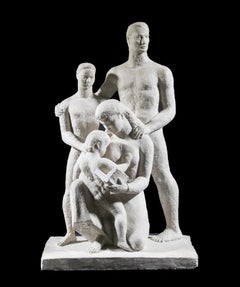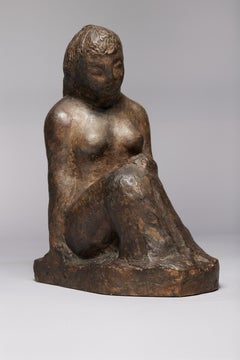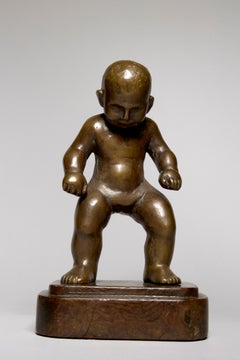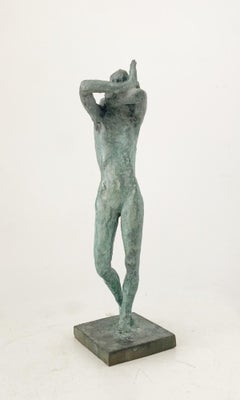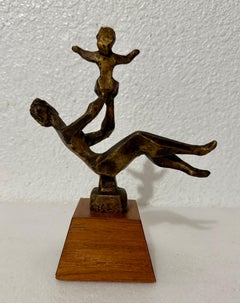William Zorach Figurative Sculptures
American, 1887-1966
Born in 1887, by 1930, he was one of America’s premier 20th century sculptors and was honored with multiple commissions and exhibitions including at the Art Institute of Chicago, the Dallas Museum of Fine Art, the Whitney Museum of American Art, and numerous others.
He studied in New York City at the National Academy of Design and also in Paris under the mentoring of Jacques-Emile Blanche. It was in Paris in the first decade of the 20th century where Zorach’s path crossed with Marguerite, his soon to be wife. Both Marguerite and William were both represented in the landmark Armory Show of 1913.
William continued to paint for the next two decades, but increasingly experimenting with sculpture. By the mid 20’s he was carving significant works in marble and stone. By the early 30’s, he abandoned painting entirely in favor of a new art form, sculpture. I t was in sculpture that Zorach found his true voice as an artist and achieved considerable success. “Sculpture, direct carving, was an expanding universe, a liberation and a natural form of expression to me.” Zorach stated.
Museum Collections:
Amon Carter Museum of American Art
Arizona State University Art Museum
Boca Raton Museum of Art
Butler Institute of American Art
Cleveland Artists Foundation
Colorado Springs Fine Arts Center
Cornish Colony Museum
Dallas Museum of Art
Delaware Art Museum
Edwin a Ulrich Museum of Art
Farnsworth Art Museum
Flint Institute of Arts
Frederick R Weisman Art Museum
Georgia Museum of Art
Herbert F Johnson Museum of Art
Jack S Blanton Museum of Art
LaSalle University Art Museum
Los Angeles County Museum of Art
Lowe Art Museum
Marion Koogler McNay Art Museum
Memorial Art Gallery
Metropolitan Museum of Art, NYC
Middlebury College Museum of Art
Minneapolis Institute of Arts
Mobile Museum of Art
Museum of Fine Art-Boston
Pennsylvania Academy of the Fine Arts
Portland Museum of Art
Smithsonian Museum of Art
The Brooklyn Museum of Art
The Canton Museum of Art
The Columbus Museum of Art-Ohio
The Columbus Museum-Georgia
The Cummer Museum Of Art & Gardens
The Currier Museum of Art
The Nelson-Atkins Museum of Art
The Newark Museum
The Phillips Collection
The Phillips Museum of Art
The University of Michigan Museum of Art
Whitney Museum of American Art
Worcester Art Museum
Yosemite Museum
to
2
1
Overall Width
to
Overall Height
to
3
1
1
1
3
2
2
2
1
1
1
1
1
1
2
1
1
9
125
100
94
89
3
Artist: William Zorach
"Pioneer Family" WPA American Modernism Plaster Maquette Realism 20th Century
By William Zorach
Located in New York, NY
"Pioneer Family," 23 1/2 x 16 1/4 x 10 3/4 inPlaster. c. 1927. Unsigned. Realism
The Smithsonian has a cast of this sculpture in its collection. Pictured on the cover of “The Sculpt...
Category
1920s American Modern William Zorach Figurative Sculptures
Materials
Plaster
Seated Nude Woman Sculpture, Early 20th Century
By William Zorach
Located in Beachwood, OH
William Zorach (American, 1887-1966)
Seated Woman
Painted plaster
Inscribed underside "V"
12.5 x 9 x 5 inches
Provenance: The Tatti Family Collection
Bill Zorach was born in Lithuan...
Category
Early 20th Century William Zorach Figurative Sculptures
Materials
Plaster
First Steps, Early 20th Century Bronze Sculpture, Cleveland School
By William Zorach
Located in Beachwood, OH
William Zorach (American 1891-1966)
First Steps, 1918
Bronze
8.5 x 5 x 4 inches, including base
Born in 1887 in Lithuania, William Zorach immigrated with his family to the United States when he was just four years old, settling in Cleveland, Ohio. Zorach displayed an exceptional artistic talent at a young age and, at the recommendation of his seventh-grade teacher, began studying lithography at night at the Cleveland School of Art. It was not long before he was apprenticing at a lithography company in Cleveland. It was there that he realized he wanted to become an artist - to escape the commercial end of the field in which he was suddenly immersed.
In 1907, Zorach saved enough money to move to New York and study art at the National Academy of Design, where he received several awards for his paintings and drawings. He continued his studies in Paris in 1910 at La Palette. This year abroad would turn out to be quite fruitful because in Paris he was greatly influenced by the Cubist and Fauvist movements and had several paintings exhibited at the Salon d'Automme. This influence and subsequent success fueled his career back in the states where he was honored with his first one-man exhibition. Due to this new-found stability, he married a young woman he met at school in Paris, and they moved to New York and set up a studio. Shortly after, their work was accepted into the famous 1913 Armory Show.
For the next nine years, Zorach continued to think of himself as a painter, although he had already begun to experiment in sculpting. He was experiencing modest success with his painting and was therefore reluctant to abandon it completely. However, he was impelled toward sculpting, and in 1922, he painted his last oil.
Zorach's involvement with sculpture began largely be accident. While he was working on a series of wood-block prints, Zorach suddenly became more interested in the butternut panel than the print and turned the panel into a carved relief. With no formal training as a sculptor, Zorach's first sculptures were of wood and his carving tools were primitive, such as a jack-knife. I n fact, his early works have a certain stylized look, suggesting the influence of various primitive arts such as African and American folk.
Zorach found his sculptural direction by instinct, but was not unaware of what other sculptors were doing, both here and abroad. He soon allied himself with a growing number of modern sculptors who believed in the esthetic necessity of carving their own designs directly in the block of stone or wood rather than modeling them in clay. From the beginning he found a deep satisfaction in the slow and patient process of freeing the image from its imprisoning block, watching the forms emerge and appear.
"The actual resistance of tough material is a wonderful guide," Zorach said in a lecture on direct sculpture in 1930. The sculptor "cannot make changes easily, there is no putting back tomorrow what was cut away today. His senses are constantly alert. If something goes wrong there is the struggle to right the rhythm. And slowly the vision grows as the work progresses." Zorach also found that the material itself had a constantly modifying effect on the artist's vision. The grain of the wood, the markings in the stone, the shape of the log or boulder all set limits and suggested possibilities. He was always sensitive to the characteristic qualities of his material and occasionally let them play a major role in determining his forms. In works such as these, the feel of the original material is preserved in the finished piece and is often heightened by leaving parts of the original surface untouched and other areas roughly marked by the sculptors tools...
Category
1910s William Zorach Figurative Sculptures
Materials
Bronze
Related Items
A woman. Contemporary figurative bronze sculpture, Polish art, Limited edition
Located in Warsaw, PL
Limited edition bronze sculpture by Polish artist Olga Prokop-Misniakiewicz. Artist signes her artworks by hand, using engraving tool. Edition of 5. Olga Prokop-Misniakiewicz likes t...
Category
2010s Post-Impressionist William Zorach Figurative Sculptures
Materials
Bronze
$1,509 Sale Price
32% Off
H 13.78 in W 3.94 in D 3.94 in
Chaim Gross Mid Century Mod Bronze Sculpture Mother and Baby Playing WPA Artist
By Chaim Gross
Located in Surfside, FL
Chaim Gross (American, 1904-1991)
Cast bronze sculpture
Caring (or Mother and Child)
signed
Mounted on wooden plinth
Featuring a mother raising her child up in superb high relied i...
Category
Mid-20th Century American Modern William Zorach Figurative Sculptures
Materials
Bronze
$2,400
H 9 in W 7.5 in D 3.5 in
Apollo Marble Bust Sculpture of Grand Tour Mythological subject 1850'
Located in Rome, IT
Finely carved mythological subject in white Carrara marble of Apollo bust .
Category
20th Century Academic William Zorach Figurative Sculptures
Materials
Marble
$6,131 Sale Price
35% Off
H 23.63 in W 16.93 in D 9.85 in
Pair of 19th century scagliola sculptures (Italian Neoclassicism) - Roman figure
Located in Varmo, IT
Pair of scagliola sculptures - Roman figures. Italian manufacture, 19th century.
51 x 26 x h 118 cm (left) - 41 x 28 x h 118 cm (right).
Made entirely of scagliola. Depicting two f...
Category
Early 19th Century Old Masters William Zorach Figurative Sculptures
Materials
Plaster
$5,660 Sale Price
20% Off
H 46.46 in W 20.08 in D 10.24 in
Fabulous Italian Neoclassical Marble Sculpture of Hermes
Located in Rome, IT
19th century French finely chiseled bronze figure of Hermes .
Signed Pigalle G . Cuspinera
Hermes , the messenger of the gods, is sitting on a rock, ready to leap up. He is att...
Category
19th Century Academic William Zorach Figurative Sculptures
Materials
Bronze
$6,602 Sale Price
20% Off
H 33.47 in Dm 17.72 in
Life-size Plaster Statue of The Callipygian Venus or Aphrodite 1920'
Located in Rome, IT
Italian life-size plaster sculpture , figure of the Callipygian Venus, after the antique Roman marble statue.
Aphrodite Kallipygos, or Callipygian Venus literally means “Venus of ...
Category
1920s Academic William Zorach Figurative Sculptures
Materials
Plaster
$8,488 Sale Price
20% Off
H 70.87 in Dm 23.63 in
Harmony, 20th century bronze & green marble base, nude man and woman with lyre
By Max Kalish
Located in Beachwood, OH
Max Kalish (American, 1891-1945)
Harmony, c. 1930
Bronze with green marble base
Incised signature on right upper side of base
14 x 9 x 5 inches, excluding base
17 x 10 x 8 inches, including base
Born in Poland March 1, 1891, figurative sculptor Max Kalish came to the United States in 1894, his family settling in Ohio. A talented youth, Kalish enrolled at the Cleveland Institute of Art as a fifteen-year-old, receiving a first-place award for modeling the figure during studies with Herman Matzen. Kalish went to New York City following graduation, studying with Isidore Konti...
Category
1930s American Modern William Zorach Figurative Sculptures
Materials
Marble, Bronze
$10,450
H 17 in W 10 in D 8 in
Apollo Marble Bust Sculpture of Grand Tour Mythological subject 1850'
Located in Rome, IT
Finely carved mythological subject in white Carrara marble of Apollo bust .
Category
20th Century Academic William Zorach Figurative Sculptures
Materials
Marble
$6,602 Sale Price
30% Off
H 23.63 in W 16.93 in D 9.85 in
Zinnia, early 20th century sculpture of nude bust of woman, Cleveland School
Located in Beachwood, OH
Walter Sinz (American, 1881-1966)
Zinnia, c. 1930
Plaster
Signed on base
9 x 8 x 4 inches
Walter A. Sinz was an American sculptor born in Cleveland, Ohio on July 13, 1881. Sinz’s fa...
Category
1930s William Zorach Figurative Sculptures
Materials
Plaster
$1,200
H 9 in W 8 in D 4 in
Exceptional Italian Neoclassical Sphinx Carrara Marble Statue
Located in Rome, IT
Outstanding Italian Neoclassical Sphinx Carrara Marble sculpture designed as entrance guardian, this mythical lady sphinx statuary display the head and chest of a neoclassical woma...
Category
1790s Academic William Zorach Figurative Sculptures
Materials
Marble
$35,000
H 23.63 in W 39.38 in D 12.6 in
Hercules Italian Stone Sculpture of Classical Torso with Base
Located in Rome, IT
This reproduction of a classical Hellenistic sculpture of Hercules .
A timeless piece for interior and a garden decoration.
We can raise with a base on request .
Category
20th Century Academic William Zorach Figurative Sculptures
Materials
Limestone
$10,846
H 50.01 in W 35.44 in D 21.66 in
Saint Michel
By Antoniucci Volti
Located in Villafranca Di Verona, IT
Numbered and limited to 8 copies
Artwork signed
Authenticity: Sold with certificate of Authenticity
Invoice from the gallery
Sculpture: bronze, metal, bronze patina
Display: The sc...
Category
1970s William Zorach Figurative Sculptures
Materials
Metal, Bronze
William Zorach figurative sculptures for sale on 1stDibs.
Find a wide variety of authentic William Zorach figurative sculptures available for sale on 1stDibs. You can also browse by medium to find art by William Zorach in bronze, metal, plaster and more. Much of the original work by this artist or collective was created during the 20th century and is mostly associated with the modern style. Not every interior allows for large William Zorach figurative sculptures, so small editions measuring 16 inches across are available. Customers who are interested in this artist might also find the work of Tom Binger, Anthony Quinn, and Bruno Lucchesi. William Zorach figurative sculptures prices can differ depending upon medium, time period and other attributes. On 1stDibs, the price for these items starts at $31,200 and tops out at $40,000, while the average work can sell for $35,600.
